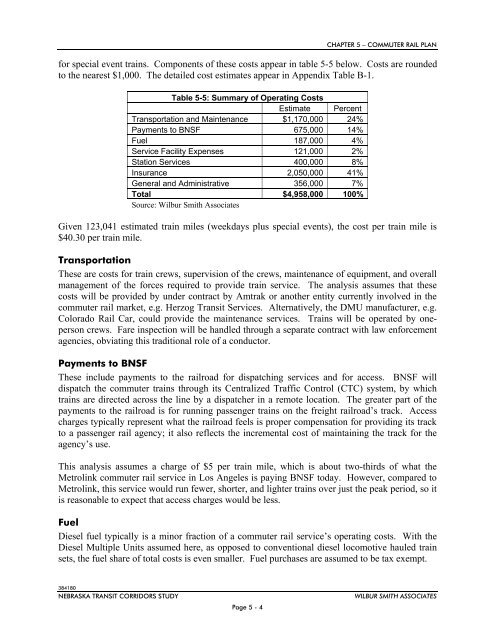NTRAC Final Study - Nebraska Department of Roads - State of ...
NTRAC Final Study - Nebraska Department of Roads - State of ...
NTRAC Final Study - Nebraska Department of Roads - State of ...
Create successful ePaper yourself
Turn your PDF publications into a flip-book with our unique Google optimized e-Paper software.
CHAPTER 5 – COMMUTER RAIL PLAN<br />
for special event trains. Components <strong>of</strong> these costs appear in table 5-5 below. Costs are rounded<br />
to the nearest $1,000. The detailed cost estimates appear in Appendix Table B-1.<br />
Table 5-5: Summary <strong>of</strong> Operating Costs<br />
Estimate Percent<br />
Transportation and Maintenance $1,170,000 24%<br />
Payments to BNSF 675,000 14%<br />
Fuel 187,000 4%<br />
Service Facility Expenses 121,000 2%<br />
Station Services 400,000 8%<br />
Insurance 2,050,000 41%<br />
General and Administrative 356,000 7%<br />
Total $4,958,000 100%<br />
Source: Wilbur Smith Associates<br />
Given 123,041 estimated train miles (weekdays plus special events), the cost per train mile is<br />
$40.30 per train mile.<br />
Transportation<br />
These are costs for train crews, supervision <strong>of</strong> the crews, maintenance <strong>of</strong> equipment, and overall<br />
management <strong>of</strong> the forces required to provide train service. The analysis assumes that these<br />
costs will be provided by under contract by Amtrak or another entity currently involved in the<br />
commuter rail market, e.g. Herzog Transit Services. Alternatively, the DMU manufacturer, e.g.<br />
Colorado Rail Car, could provide the maintenance services. Trains will be operated by oneperson<br />
crews. Fare inspection will be handled through a separate contract with law enforcement<br />
agencies, obviating this traditional role <strong>of</strong> a conductor.<br />
Payments to BNSF<br />
These include payments to the railroad for dispatching services and for access. BNSF will<br />
dispatch the commuter trains through its Centralized Traffic Control (CTC) system, by which<br />
trains are directed across the line by a dispatcher in a remote location. The greater part <strong>of</strong> the<br />
payments to the railroad is for running passenger trains on the freight railroad’s track. Access<br />
charges typically represent what the railroad feels is proper compensation for providing its track<br />
to a passenger rail agency; it also reflects the incremental cost <strong>of</strong> maintaining the track for the<br />
agency’s use.<br />
This analysis assumes a charge <strong>of</strong> $5 per train mile, which is about two-thirds <strong>of</strong> what the<br />
Metrolink commuter rail service in Los Angeles is paying BNSF today. However, compared to<br />
Metrolink, this service would run fewer, shorter, and lighter trains over just the peak period, so it<br />
is reasonable to expect that access charges would be less.<br />
Fuel<br />
Diesel fuel typically is a minor fraction <strong>of</strong> a commuter rail service’s operating costs. With the<br />
Diesel Multiple Units assumed here, as opposed to conventional diesel locomotive hauled train<br />
sets, the fuel share <strong>of</strong> total costs is even smaller. Fuel purchases are assumed to be tax exempt.<br />
384180<br />
NEBRASKA TRANSIT CORRIDORS STUDY<br />
Page 5 - 4<br />
WILBUR SMITH ASSOCIATES

















